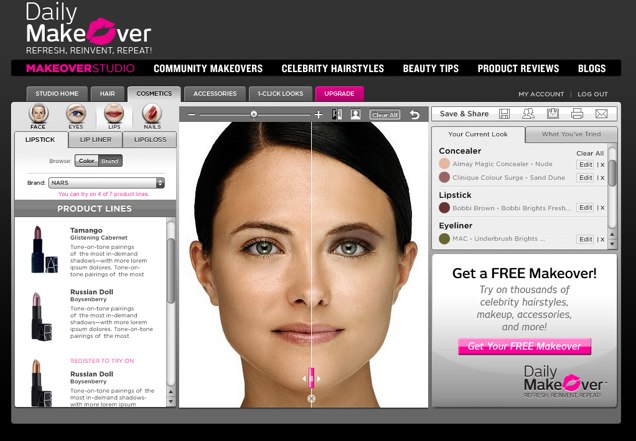
As facial recognition and virtual try-on technologies continue to improve, there is an opportunity to use this innovation for the cosmetics industry. Last year, we reviewed Taaz, a virtual makeover site that lets you alter the makeup and hair of a photo of yourself (or a celeb like Angelina Jolie). This week, startup Daily Makeover is launching a new version of its similar product, Makeover Studio, which could make the online makeover process even more detailed and easy to use.
Makeover Studio, which can be used on Daily Makeover’s standalone site and is licensed to more than 60 beauty brands, including Avon and Mary Kay, and web media publishers, lets women upload a picture of themselves (or use a model’s picture) and then try on makeup and hair styles virtually. Women can try on specific brands of makeup in all different shades and styles. When a woman uploads the photo onto the platform, her face is instantly traced using facial recognition technology so that all the different application techniques such as a smoky eye shadow effect or a blush technique can be superimposed on her face in the correct area. Plus, women are able to try on different brands of products in each genre of makeup. So you could try a Dior blush and a Lancome blush and compare the looks on your face.
The new version of Makeover Studio (which will be released later this week) includes new rendering functionality, visualization technology and face-tracing capabilities. The latest version has also added a more expansive list of makeup finishes, including satin, matte, metallic, shimmer, stained, dewy, sheer, and glossy in an attempt to show the reality of the finish of the makeup on a woman’s skin. Makeover Studio has added an option for women to adjust the placement and coverage levels of foundations, concealers, lip colors, eye shadows, mascara, and blush. The detail that Makeover Studio offers to women is compelling. You can differentiate between a lengthening mascara and a thickening mascara or determine how glossy a lipgloss is compared to a lipstick.
Of course, makeup is a set of products that is difficult to buy (especially if the product is pricey) without seeing what it looks like on your face. Daily Makeover says that Makeover Studio’s technology can help bridge this gap in the online space for cosmetics, perhaps now allowing women to get the same trying-on opportunities they would find in a department or retail store for a cosmetics company. Currently on Taaz, you can purchase the cosmetics your “virtually” try on, which is unavailable on Daily Makeover’s site. But companies can brand the makeover application and let users email and publish their “makeovers” to social networking sites, such as Facebook and MySpace.
There’s no doubt that buying and trying on makeup online is certainly disruptive to the cosmetics industry. But I’m still a little skeptical as to whether the online experience is the same as trying on a product at the beauty counter. When you try on the product at a beauty counter, you see the technique of putting a particular eyeliner or blush on, which isn’t shown on the Makeover Studio. It’s unclear if masses of women will trust that the makeover technology using virtual tools, such as Makeover Studio, is as accurate as actually trying on makeup. That being said, if you can combine the experiences of trying on and learning how to use a cosmetic product into an e-commerce platform, this could closely resemble the experience at the beauty counter.